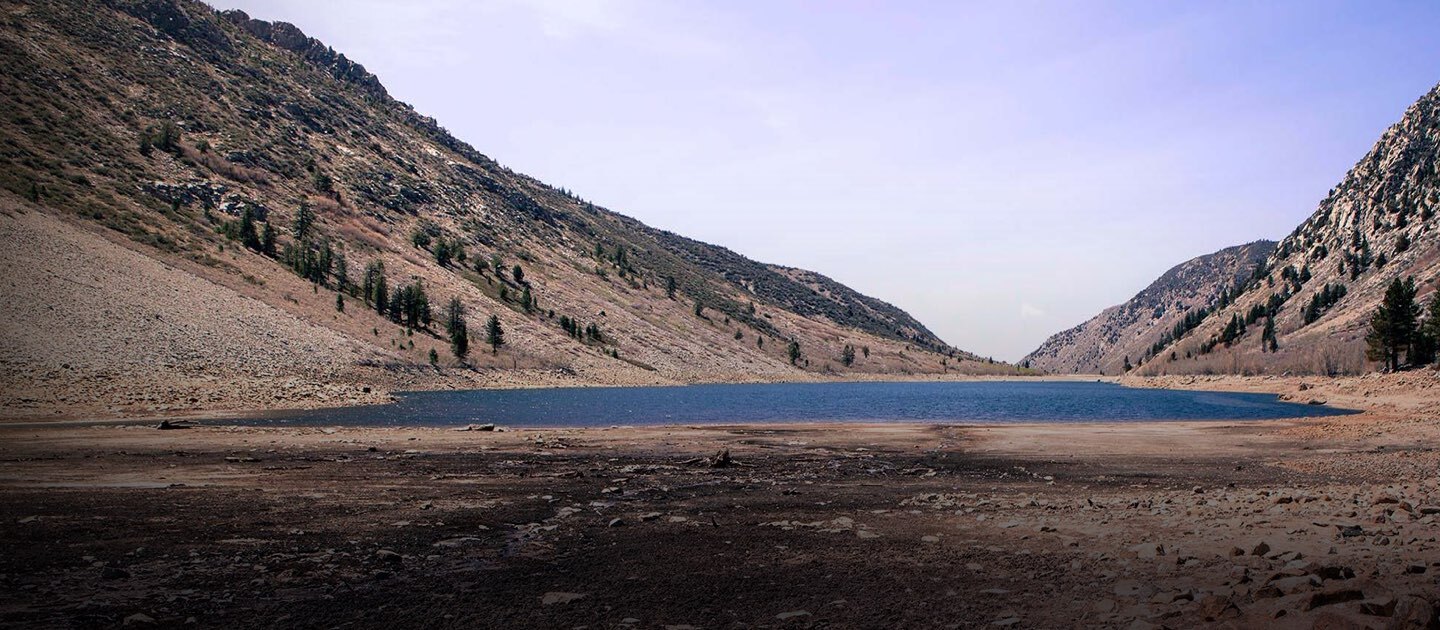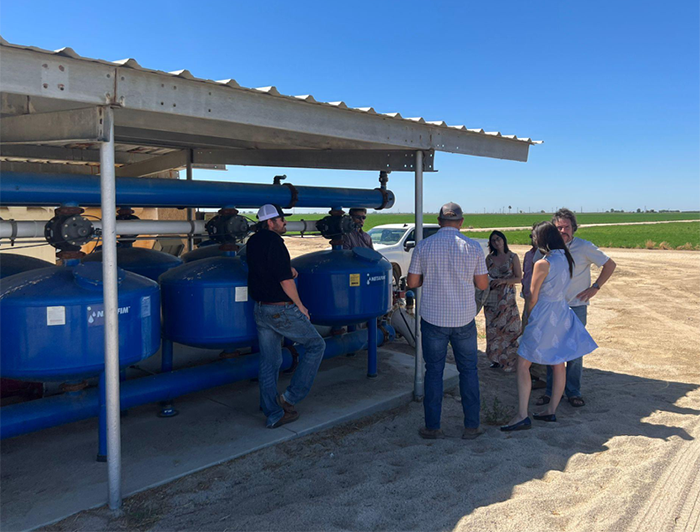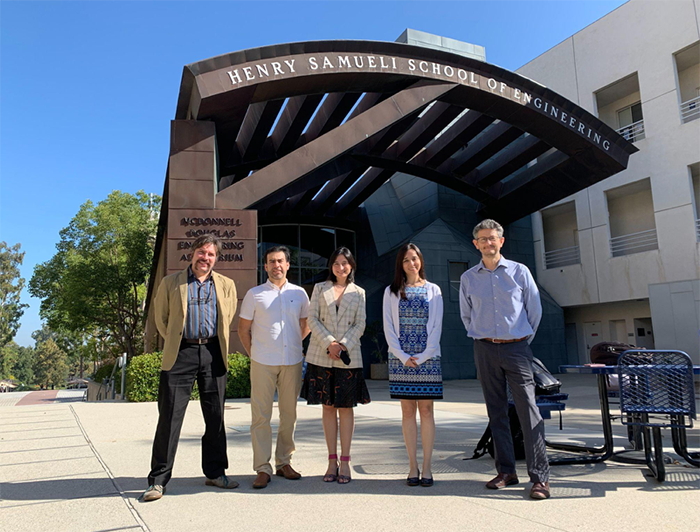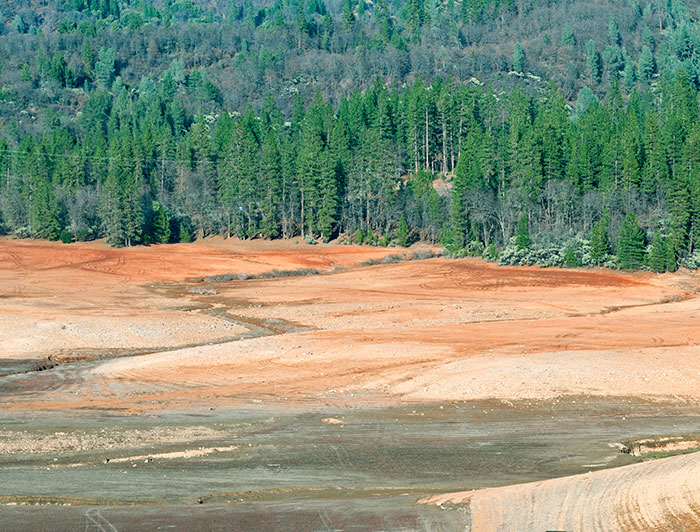
What Chile Can Learn From California's Fight Against the Drought
During a recent visit to California, UC Chile and Chilean government authorities got a first-hand look at some measures that deal with droughts, including planning, water storage techniques and remote detection tools to monitor the impact.

photo_camera In California, various filtration systems have been devised (as seen in the photo) in which already settled wastewater is carried from barns. The filters remove contaminants from the water, which is then mixed with clean water to obtain irrigation water. (Photo credit: UC Chile Drought Initiative)
The climates of both California and central Chile are strikingly similar. Some similarities are undeniable: both territories have gentle rainy winters followed by long, dry and hot summers, and are currently facing an extreme adverse water scenario.
Looking to identify tools and learn from the measures implemented by this American state to address the lack of water, a delegation of UC Chile faculty and government officials recently traveled to California.
The delegation consisted of:
- Representatives of the National Research and Development Agency Sequía FSEQ210018 project (ANID, as per its Spanish acronym)
- Jorge Gironás, Sebastián Vicuña, Daniela Rivera, and Oscar Melo, all from the UC Chile Drought Initiative
- Cristian Núñez, Deputy National Director of the General Water Department
- Pilar Barría, Water and Governance Advisor of the Ministry of the Environment
Meetings were held with experts and academics from various universities, including:
- University of California Irvine
- University of California Merced
- University of California Davis
- University of California Berkeley
- Stanford University
These also included the participation of different water districts and agencies, among them:
- Metropolitan Water District of Southern California
- California Water Commission
- State Water Resources Control Board
- California Department of Water Resources
The aim was to identify and assess policies and technologies that could be implemented in our country to better manage the 13th year record-breaking drought.
In turn, these entities were also interested in the current water situation and actions in Chile.
Measures Learned During the Visit
The use of satellite information to characterize large-scale water resources, as well as the behavior and impacts of drought, were analyzed at the University of California Irvine.
One of the tools implemented at the university is the Persiann platform. It was developed to integrate important hydrometeorological information into management and decision making. The platform includes: historical records, real-time information and projections of climate change around the world, with material that can be viewed and downloaded by users worldwide.
The experience of wastewater treatment and reuse in Orange County was also presented at the university. After being treated in a plant, the water is injected into the aquifer, which increases its reserves.
In this regard, Dr. Shannon Roback of Water UCI stressed the importance of having a multidimensional approach to drought, including cultural changes that must be introduced so that people accept and embrace the direct reuse of treated wastewater.
The work of the water agencies in California has been precisely focused on promoting conservation and educating the population in order to maintain a balance between water supply and demand.
In this line, nature-based solutions are being implemented, such as state acquisition of land for rainwater infiltration. This allows recharging water in times of surplus and, at the same time, controlling floods.

The Metropolitan Water District of Southern California is the largest water supplier in the state of California, serving 19 million people in 26 districts.
Two aqueducts, which run for over 310 miles, distribute the water to the counties, reservoirs and treatment plants. This large project is financed through bonds, water sales and land taxes.
Today, the agency’s focus has shifted from infrastructure construction to demand management to ensure the sustainability of the resource.
To this end, various initiatives have been implemented for planning, introducing cultural and technological changes, educating the population and oversight.
Through the incentive program bewaterwise.com, the company has sought to reduce residential and commercial water consumption by providing rebates for water-efficient plumbing fixtures, appliances and equipment.
Agriculture in Times of Drought
Undoubtedly, one of the sectors most affected by the drought in both California and Chile is agriculture.
Groundwater management is a key issue for the agricultural world, as explained by the Center for Watershed Sciences at the University of California Davis.
California has a large water storage capacity (especially groundwater), which is particularly relevant in times of drought.
In 2014, an Act came into force to ensure its sustainable management (Sustainable Groundwater Management Act). Its impact is not yet well known, as it is still in the process of being implemented. Regardless, it has been a great challenge for all stakeholders involved in water management.
A key element of the law is that it defines sustainability goals and not necessarily efficiency goals. Its focus is to halt overdraft and bring groundwater basins into balanced levels of pumping and recharge, without forgetting the need for aquifer recovery.
Previously, the traditional efficiency approach sought to encourage lower water use per hectare but did not give guidelines as to what to do with the water saved.
When poorly managed, this approach can lead to undesirable increases in total water consumption, without ensuring the conservation and sustainability of the resource.

Thanks to water exchanges between farmers, economic losses have been reduced, avoiding a significant loss of the State's GDP.
The California Department of Water Resources has introduced the MAR program, which seeks to use flood water for managed aquifer recharge (MAR) on agricultural land and other areas.
This favors agricultural activity.
In addition, another interesting thing is that the market in California focuses on water volumes, as well as infrastructure.
This has been a crucial tool for drought management, as it has provided flexibility for redistribution. The economic impact of drought can be reduced by reallocating water quickly from lower to higher value uses, typically in agriculture.
Desalination in the Back Seat
In meetings held with academics and authorities in California, it was argued that desalination, particularly of seawater, it is not as advisable as other options given the economic, energy, environmental and social costs of desalination.
In their view, other management alternatives to face drought and water scarcity should be advanced first, including:
- Water treatment and reuse
- Groundwater recharge and storage
- Improved efficiency
- Consumption reduction
As a central management practice, desalination only comes last in terms of priority.
However, experts state that we will need to resort to massive desalination (mainly of inland waters) in the future, so today's research should point in that direction and be prepared for what is to come.
What Chile Can Learn From California

In the meetings held with the directors of the main water management agencies in California (California Water Commission, State Water Resources Control Board and the California Department of Water Resources), the main lessons learned from the California drought were reviewed.
Some of these lessons are:
- To act quickly in the event of an adverse water scenario.
- To acknowledge that temperature increases are creating new impacts or intensifying existing ones.
- To transition from considering drought as an occasional emergency to a resilience-based approach when facing an increasingly arid climate.
Today, drought is considered a normal part of California's climate and hydrologic cycle, not an emergency in and of itself.
Its impacts are specific and vary depending on the ability of users to invest in resilience.
One of the conclusions that can be drawn from the meetings is the need for and importance of generating proactive policies in the face of drought, accepting it as a structural factor of the country's water management, and planning for an adverse scenario, but without forgetting the wettest years.
According to Jorge Gironás, Daniela Rivera, Sebastián Vicuña and Oscar Melo, UC Chile professors participating in this visit, to achieve this goal, collaboration between decision-makers (public authorities), users and academia is essential, as is the case in California.
“The trip to California was very productive. We had the opportunity to learn about the implementation of their aquifer management policy from different points of view: from the State, from the users, and from the agencies,” said Pilar Barría.
Despite the difficulties involved in such a change of management, efforts were made to recognize that drought is a structural part of the operation and not an exceptional situation, thus strengthening the water sector's resilience process.
“It is also very interesting to understand the policy gaps and challenges, for example, in monitoring, as these are aspects that we can consider in the reforms we are implementing as a country.”
For Cristian Núñez, Director of the General Water Department of the MOP, “It is very important to continue advancing in these types of projects that incorporate research and the transfer of technical knowledge on water management, both in times of scarcity and in extreme flooding events.” Both are increasingly recurrent with climate change.
This technical visit to different state entities and research centers of California universities provided a better understanding of the relevance of measuring, controlling and monitoring the flows consumed, explained Núñez.
The new Chilean Water Code, enacted on April 6, 2022, is aligned with this management approach of both watercourses (surface water) and aquifers (groundwater).
Not only that, but it also provides tools for key activities in the management, optimization and reduction of water consumption, along with the ability to diversify and change agricultural crops in an efficient and timely manner in times of drought.
Another key factor is to promote and control water recharge and extraction from aquifers, as well as water reuse, said Núñez.
“California's problem is similar to that of our country. Just as they did, we need to improve the quality and standards of measurement and information available on aquifers. We must also streamline and optimize control processes to ensure and guarantee to users that everyone extracts what they should, both in times of drought and in normal or rainy years. We must also measure the effectiveness of aquifer recharge measures, which should be aimed at infrastructure or works that are quick to implement and operate, and at a reasonable cost.”
While Núñez valued the visit, for him the most important thing was to have opened lines of communication with the water management agencies in California in order to continue sharing experiences.


